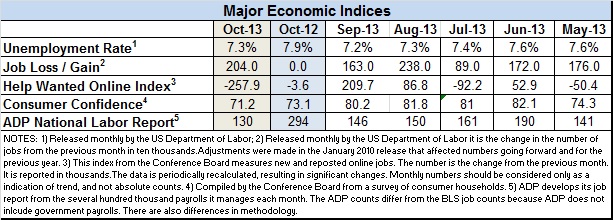Late-night comedians will have a field day with the October jobs report released in the U.S. today — shut down the government and job creation increases.
Although the unemployment rate ticked up slightly to 7.3 percent, the 204,000 jobs reportedly created last month exceeded what economists were expecting, leading some to suspect the numbers.
“I find this bizarre,” Mark Zandi told CNBC. “I wouldn’t be surprised if this gets revised to some degree … down.” He is chief economist for Moody’s Analytics, which partners with ADP in producing the HR services firm’s National Employment Report. That report, out last week, said 130,000 private sector jobs were added to the economy in October.
Shutdown didn’t seem to impact hiring
October’s government report from the U.S. Bureau of Labor Statistics, put the number of new private sector jobs at 212,000. Cuts in government jobs, not included in the ADP report, dropped the net new job total to 204,000.
At the same time, the BLS revised up by 60,000 the initial job numbers for August and September, sowing both optimism about the strength of the economy and worries the Federal Reserve will begin scaling back on programs that have kept interest rates low. As a result, the market reaction to the jobs report was mixed.
 Economists expected that the government shutdown during the first 16 days of the month would up the unemployment rate. Most, though, expected job growth of about 120,000.
Economists expected that the government shutdown during the first 16 days of the month would up the unemployment rate. Most, though, expected job growth of about 120,000.
“The government shutdown really didn’t have a material impact on employment,”said Brian Jones, senior U.S. economist at Societe Generale in New York, whose forecast for a payroll gain of 175,000 was the highest in the Bloomberg survey. “The labor market is actually quite healthy, regardless of what people may think. The economy is doing better.”
Retail sector added 44,000 jobs
The biggest increases were seen in the leisure and hospitality sector, which added 53,000 jobs. The sector growth was driven by 29,300 new jobs in restaurants and bars. Retail added 44,400 jobs, spread amongst the various categories including electronics and appliance stores, auto service stations, and food and beverage stores. Clothing stores lost 12,500 jobs.
Manufacturing and construction both also had strong job growth. Manufacturing added 19,000 jobs, with almost a third coming in auto manufacturing and parts. The construction industry added 12,000 jobs.
For reasons having to do with how unemployment and the size of the workforce is calculated, and the fact that the government shutdown furloughed the statisticians and economists at the Bureau of Labor Statistics, delaying the issuance of today’s report and several others, the numbers were expected to be “noisy,” in economic parlance.
For example, the report included an explanation of how the BLS classified furloughed government workers, which noted that errors in classification were possible. In the report, the 11.3 million workers counted as unemployed, included 448,000 who said they were on temporary layoff.
Labor force participation drops again
“While the furloughed government workers technically should be counted as employed in the non-farm payroll count as part of the establishment survey, at the same time they are counted as temporarily unemployed in the household survey,” said Kathy Bostjancic, director of macroeconomic analysis at The Conference Board.
(The BLS uses two different types of surveys to determine job growth and employment. One is filled out by private individuals; the other by businesses.)
The government also reported that the civilian labor force participation ration dropped by 720,000 during the month, which would typically have prevented the unemployment rate from rising, if not cut it. The participation rate decreased to 62.8 percent, the lowest since March 1978. It was at 63.2 percent a month earlier.
It may not be until January, when the December jobs report is released, that the numbers stabilize.
